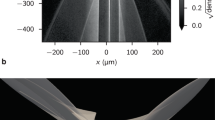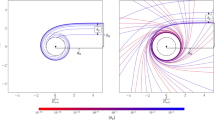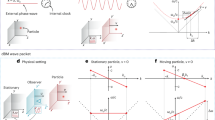Abstract
Singularities underlie many optical phenomena1. The rainbow, for example, involves a particular type of singularity—a ray catastrophe—in which light rays become infinitely intense. In practice, the wave nature of light resolves these infinities, producing interference patterns. At the event horizon of a black hole2, time stands still and waves oscillate with infinitely small wavelengths. However, the quantum nature of light results in evasion of the catastrophe and the emission of Hawking radiation3. Here I report a theoretical laboratory analogue of an event horizon: a parabolic profile of the group velocity7 of light brought to a standstill in an atomic medium4,5,6 can cause a wave singularity similar to that associated with black holes. In turn, the quantum vacuum is forced to create photon pairs with a characteristic spectrum, a phenomenon related to Hawking radiation3. The idea may initiate a theory of ‘quantum’ catastrophes, extending classical catastrophe theory8,9.
This is a preview of subscription content, access via your institution
Access options
Subscribe to this journal
Receive 51 print issues and online access
$199.00 per year
only $3.90 per issue
Buy this article
- Purchase on Springer Link
- Instant access to full article PDF
Prices may be subject to local taxes which are calculated during checkout



Similar content being viewed by others
References
Berry, M. V. & Upstill, C. Catastrophe optics: morphologies of caustics and their diffraction patterns. Prog. Opt. XVII, 257–346 (1980).
Misner, Ch. W., Thorne, K. S. & Wheeler, J. A. Gravitation (Freeman, New York, 1999).
Hawking, S. M. Black hole explosions? Nature 248, 30–31 (1974).
Liu, Ch., Dutton, Z., Behroozi, C. H. & Hau, L. V. Observation of coherent optical information storage in an atomic medium using halted light pulses. Nature 409, 490–493 (2001).
Philips, D. F., Fleischhauer, A., Mair, A., Walsworth, R. L. & Lukin, M. D. Storage of light in atomic vapor. Phys. Rev. Lett. 86, 783–786 (2001).
Dutton, Z., Budde, M., Slowe, C. & Hau, L. V. Observation of quantum shock waves created with ultra-compressed slow light pulses in a Bose-Einstein condensate. Science 293, 663–668 (2001).
Born, M. & Wolf, E. Principles of Optics (Cambridge Univ. Press, Cambridge, 1999).
Thom, R. Stabilité Structurelle et Morphogénèse (Benjamin, Reading, 1972).
Poston, T. & Stewart, I. Catastrophe Theory and its Applications (Dover, Mineola, 1996).
Schleich, W. & Scully, M. O. in New Trends in Atomic Physics (Les Houches session XXXVIII, Elsevier, Amsterdam, 1984).
Wang, L. J., Kuzmich, A. & Dogariu, A. Gain-assisted superluminal light propagation. Nature 406, 277–279 (2000).
Hau, L. V., Harris, S. E., Dutton, Z. & Behroozi, C. H. Light speed reduction to 17 metres per second in an ultracold atomic gas. Nature 397, 594–598 (1999).
Scully, M. O. & Zubairy, M. S. Quantum Optics (Cambridge Univ. Press, Cambridge, 1997).
Fleischhauer, M. & Lukin, M. D. Dark-state polaritons in electromagnetically-induced transparency. Phys. Rev. Lett. 84, 5094–5097 (2000).
Leonhardt, U. & Pinwicki, P. Relativistic effects of light in moving media with extremely low group velocity. Phys. Rev. Lett. 84, 822–825 (2000).
Weinberg, S. The Quantum Theory of Fields (Cambridge Univ. Press, Cambridge, 1999).
Erdélyi, A., Magnus, W., Oberhettinger, F. & Tricomi, F. G. Higher Transcendental Functions (McGraw-Hill, New York, 1981).
Ablowitz, M. J. & Fokas, A. S. Complex Variables (Cambridge Univ. Press, Cambridge, 1997).
Brout, R., Massar, S., Parentani, R. & Spindel, Ph. A primer for black hole quantum physics. Phys. Rep. 260, 329–446 (1995).
Birrell, N. D. & Davies, P. C. W. Quantum Fields in Curved Space (Cambridge Univ. Press, Cambridge, 1982).
Unruh, W. G. Notes on black-hole evaporation. Phys. Rev. D 14, 870–892 (1976).
Mandel, L. & Wolf, E. Optical Coherence and Quantum Optics (Cambridge Univ. Press, Cambridge, 1995).
Unruh, W. G. Experimental black-hole evaporation? Phys. Rev. Lett. 46, 1351–1353 (1981).
Visser, M. Acoustic black holes: horizons, ergospheres and Hawking radiation. Class. Quantum Grav. 15, 1767–1791 (1998).
Jacobson, T. A. & Volovik, G. E. Event horizons and ergoregions in 3He. Phys. Rev. D 58, 064021-1–064021-7 (1998).
Volovik, G. E. Simulation of a Panlevé-Gullstrand black hole in a thin 3He-A film. JETP Lett. 69, 705–713 (1999).
Garay, L. J., Anglin, J. R., Cirac, J. I. & Zoller, P. Sonic analog of gravitational black holes in Bose-Einstein condensates. Phys. Rev. Lett. 85, 4643–4647 (2000).
Reznik, B. Origin of the thermal radiation in a solid-state analogue of a black hole. Phys. Rev. D 62, 044044-1–044044-7 (2000).
Chapline, G., Hohlfeld, E., Laughlin, R. B. & Santiago, D. I. Quantum phase transitions and the breakdown of classical general relativity. Phil. Mag. B 81, 235–254 (2001).
Schwinger, J. On gauge invariance and vacuum polarization. Phys. Rev. 82, 664–679 (1951).
Acknowledgements
The Royal Institution discussion meeting on artificial black holes was an inspiration for this work, and I thank the participants and organizers. I acknowledge the support of the ESF programme Cosmology in the Laboratory.
Author information
Authors and Affiliations
Corresponding author
Rights and permissions
About this article
Cite this article
Leonhardt, U. A laboratory analogue of the event horizon using slow light in an atomic medium. Nature 415, 406–409 (2002). https://doi.org/10.1038/415406a
Received:
Accepted:
Issue Date:
DOI: https://doi.org/10.1038/415406a
This article is cited by
-
Envelope Dyadic Green’s Function for Uniaxial Metamaterials
Scientific Reports (2019)
-
Large Fizeau’s light-dragging effect in a moving electromagnetically induced transparent medium
Nature Communications (2016)
-
GUP assisted Hawking radiation of rotating acoustic black holes
Astrophysics and Space Science (2016)
-
Experimental demonstration of photonic quantum ratchet
Science Bulletin (2015)
-
Observation of self-amplifying Hawking radiation in an analogue black-hole laser
Nature Physics (2014)
Comments
By submitting a comment you agree to abide by our Terms and Community Guidelines. If you find something abusive or that does not comply with our terms or guidelines please flag it as inappropriate.



